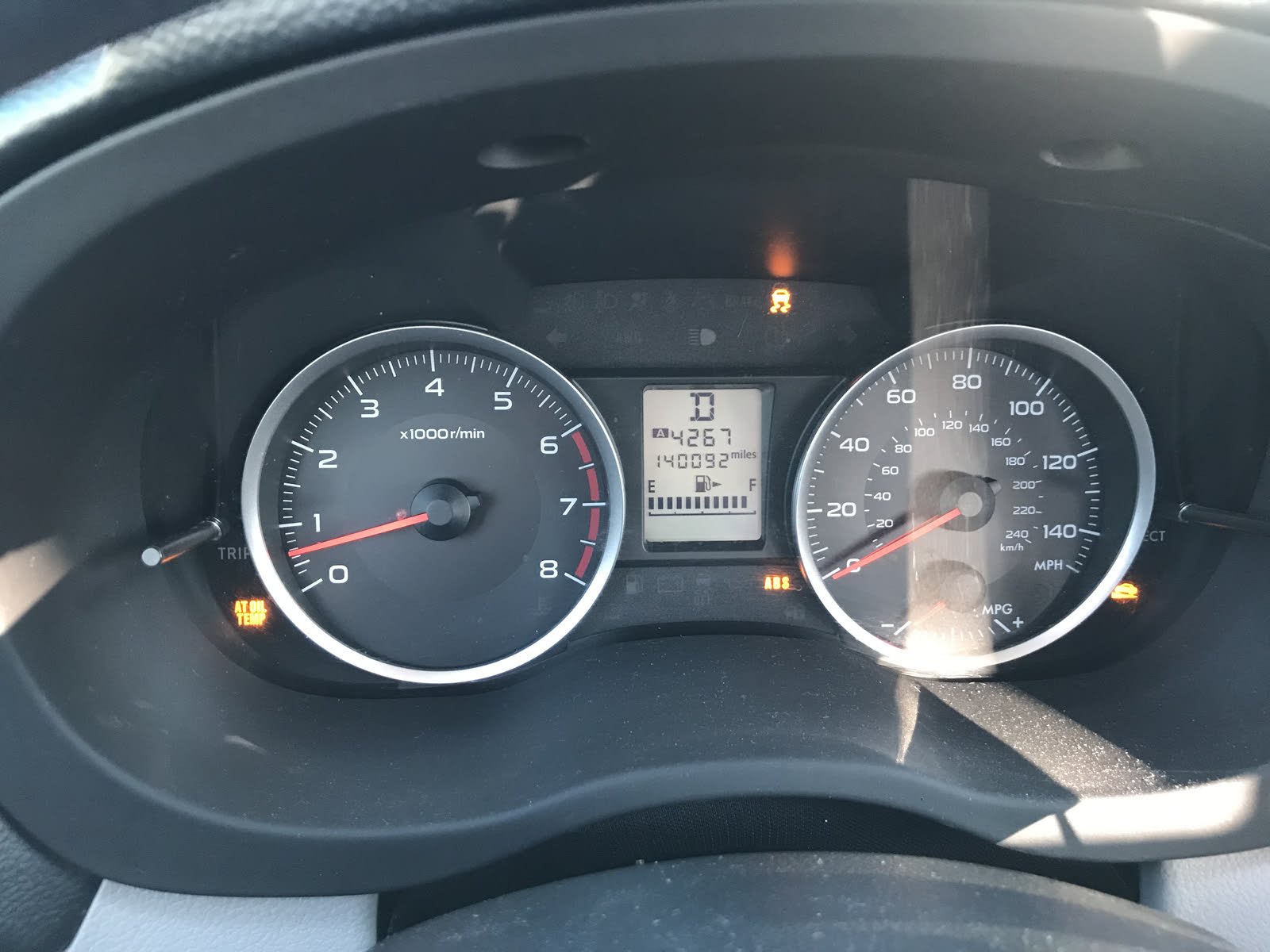The Toyota Rav4 AT Oil Temp Light indicates a potential issue with the automatic transmission’s oil temperature. Your Toyota Rav4 AT Oil Temp Light illuminating could signal a problem with your vehicle’s automatic transmission oil temperature.
This light serves as a warning that the transmission is overheating, which could lead to damage if not addressed promptly. It is important to stop the vehicle, let the engine cool down, and have the transmission checked by a qualified mechanic to prevent further damage.
Ignoring this warning could result in costly repairs. We will discuss common reasons for the AT Oil Temp Light to come on and what steps you can take to resolve the issue.
Common Causes Of At Oil Temp Light
Understanding the common causes of AT Oil Temp Light in your Toyota Rav4 is essential to ensure the proper functioning and longevity of your transmission. This indicator light is designed to alert you to potential issues with your transmission’s temperature, which, if left unaddressed, can lead to severe damage and costly repairs. In this section, we will explore the common causes of AT Oil Temp Light in your Toyota Rav4, including low fluid level and overheating transmission.
Low Fluid Level
One common cause of the AT Oil Temp Light in your Toyota Rav4 is a low fluid level in the transmission system. Transmission fluid plays a vital role in keeping the transmission lubricated, cool, and functioning properly. When the fluid level drops below the recommended range, it can lead to increased friction, heat buildup, and ultimately trigger the AT Oil Temp Light.
- Regularly check the transmission fluid level according to your vehicle’s maintenance schedule.
- Ensure the transmission fluid is at the appropriate level, using the dipstick provided.
- If the fluid level is low, add the recommended transmission fluid as per your vehicle’s specifications.
Overheating Transmission
Another common cause of the AT Oil Temp Light in your Toyota Rav4 is an overheating transmission. Excessive heat can occur due to various factors, such as heavy towing, prolonged stop-and-go driving, or insufficient airflow to the transmission system. When the transmission overheats, it puts additional strain on the components, resulting in poor performance and potential damage.
- Avoid overloading your vehicle and exceeding the recommended towing capacity.
- Take breaks during long drives to allow the transmission to cool down.
- Check for any obstructions in the transmission cooling system, such as clogged fins or debris.
- Consider installing additional cooling mechanisms, such as external transmission coolers, to help regulate the transmission temperature.
By understanding these common causes and taking preventive measures, you can minimize the risk of your Toyota Rav4’s AT Oil Temp Light illuminating and ensure the smooth operation of your transmission. Remember to always consult your vehicle’s owner’s manual and seek professional assistance if you have any concerns about your transmission’s temperature or performance.
Checking And Adding Transmission Fluid
One important aspect of maintaining your Toyota RAV4 is regularly checking and adding transmission fluid. The transmission fluid plays a crucial role in the smooth operation of your vehicle’s transmission system, ensuring that it stays lubricated and performs optimally. In this section, we will discuss the process of checking and adding transmission fluid to your Toyota RAV4, helping you keep your vehicle running smoothly.
Locating The Transmission Fluid Dipstick
Locating the transmission fluid dipstick is the first step in checking and adding transmission fluid. The dipstick is a long, narrow tool with markings that indicate the fluid levels. To locate it, follow these steps:
- Ensure that your Toyota RAV4 is on a level surface and the engine is turned off.
- Open the hood of your vehicle and locate the transmission fluid dipstick, often labeled as “ATF” or “Transmission Fluid.”
- Once you’ve found the dipstick, remove it from its housing by pulling it out.
- Wipe the dipstick clean using a lint-free cloth or paper towel to remove any residue.
- Insert the dipstick back into its housing fully, then remove it again to check the transmission fluid level.
Adding Transmission Fluid
If the transmission fluid level is below the recommended level, it’s crucial to add more fluid. Follow these steps to add transmission fluid to your Toyota RAV4:
- Locate the transmission fluid fill port, which is typically near the dipstick housing.
- Remove the transmission fluid fill port cap or plug.
- Using a funnel, pour the correct type of transmission fluid into the fill port. Refer to your vehicle’s user manual or consult a professional to ensure you’re using the right fluid for your RAV4.
- Add the fluid in small increments, frequently checking the dipstick to prevent overfilling.
- Once the fluid level reaches the recommended range on the dipstick, stop adding fluid.
- Replace the transmission fluid fill port cap or plug securely.
Proper maintenance of your Toyota RAV4 includes regularly checking and adding transmission fluid as needed. By following these steps, you can help ensure that your vehicle’s transmission system remains in excellent condition, promoting a smooth and reliable driving experience.
Cooling System Inspection
Ensure optimal performance and prevent potential issues with a thorough cooling system inspection for your Toyota Rav4. Keep an eye out for warning signs such as the at oil temp light, which may indicate underlying concerns that need prompt attention.
Regular checks can help maintain your vehicle’s efficiency and durability.
Proper maintenance and regular inspection of your Toyota Rav4’s cooling system is crucial to ensure optimal performance and prevent any potential issues. The cooling system is responsible for regulating the engine’s temperature, keeping it within safe operating levels. In this section, we will discuss two important aspects of cooling system inspection: checking for leaks and coolant level inspection.
Checking For Leaks
Regularly checking for leaks in your Toyota Rav4’s cooling system is essential to identify any potential problems before they worsen. Leaks can occur in various parts of the system, including hoses, radiator, water pump, thermostat housing, and the heater core. To check for leaks, follow these steps:
- Start by visually inspecting the engine bay for any signs of coolant leakage. Look for puddles or stains underneath the vehicle.
- Next, inspect the hoses and connections. Check for any visible cracks, bulges, or signs of wear. Make sure all hose clamps are tightened properly.
- Examine the radiator for any signs of leakage, such as wet or discolored areas. Inspect the radiator cap for any signs of damage or corrosion.
- Inspect the water pump, thermostat housing, and the heater core for any visible leaks or abnormalities.
- If you suspect a leak but cannot visually identify it, you may consider performing a pressure test. This involves using a pressure tester to apply pressure to the cooling system and check for any drop in pressure, indicating a leak.
Coolant Level Inspection
Maintaining the proper coolant level is vital for the cooling system to function efficiently. Low coolant levels can lead to overheating and potential engine damage. Follow these steps to inspect the coolant level:
- Ensure the engine is cold before checking the coolant level. Opening the radiator cap when the engine is hot can cause serious burns.
- Locate the coolant reservoir, typically a translucent plastic tank near the radiator. It is labeled with “Coolant” or “Antifreeze.”
- Carefully remove the cap from the coolant reservoir and check the level. The coolant should be between the minimum and maximum marks.
- If the coolant level is below the minimum mark, add a 50/50 mixture of coolant and distilled water to bring it up to the desired level.
- Ensure the cap is securely tightened after inspecting the coolant level.
Regularly inspecting your Toyota Rav4’s cooling system for leaks and maintaining the proper coolant level will help ensure optimal performance and avoid any potential issues. If you notice any leaks or have concerns about the cooling system, it is recommended to have it inspected and repaired by a qualified technician.
Credit: www.subaruoutback.org
Avoiding Common Missteps
When it comes to avoiding common missteps with the Toyota Rav4 At Oil Temp Light, it’s important to steer clear of overused words and phrases. human-like writing style.
Ignoring The Warning Light
One common misstep that many Toyota Rav4 owners make when the AT Oil Temp Light illuminates on their dashboard is simply ignoring it. Some may brush it off as a minor issue that will go away on its own, while others may believe that it’s just a glitch in the system. However, ignoring this warning light can lead to serious consequences for both your car and your wallet.
The AT Oil Temp Light is an important indicator that alerts you to potential problems with the automatic transmission fluid temperature in your Rav4. When this light comes on, it’s a signal that the transmission is overheating and needs immediate attention. By ignoring this warning, you run the risk of causing further damage to your transmission and potentially even complete transmission failure.
Driving with an overheated transmission can result in sluggish performance, gear shifting issues, and increased wear and tear on the internal components of the transmission. Furthermore, continuing to operate your Rav4 with an overheated transmission can lead to costly repairs and potentially even the need for a full transmission replacement.
Continuing To Drive
Another mistake that Rav4 owners sometimes make when the AT Oil Temp Light comes on is continuing to drive as if nothing is wrong. This is especially common when the warning light comes on during a long drive or in the middle of a road trip. However, pushing through and ignoring the warning can have severe consequences.
When the AT Oil Temp Light is illuminated, it’s a clear indication that the transmission is not functioning within its optimal temperature range. Continuing to drive under these conditions can result in further overheating and potential damage to the transmission components. The longer you drive with an overheated transmission, the higher the risk of permanent damage.
It’s important to remember that the transmission is a critical component of your Rav4 and a key factor in its overall performance and reliability. By taking immediate action when the AT Oil Temp Light comes on, you can avoid exacerbating the problem and potentially save yourself from costly repairs down the line.
Seeking Professional Assistance
Consulting A Mechanic
If you notice the AT Oil Temp light on your Toyota Rav4, it’s crucial to seek professional assistance. Consulting a certified mechanic is the first step in resolving any transmission issues. Look for a reputable auto repair shop or dealership with experience in addressing similar concerns.
Diagnosing Transmission Issues
When dealing with the AT Oil Temp light, it’s important to have the transmission system thoroughly diagnosed. A mechanic will use specialized diagnostic equipment to identify potential issues. They will inspect the transmission fluid levels and condition, check for leaks, and run electronic diagnostics to pinpoint any malfunctions.

Credit: www.reddit.com

Credit: www.cargurus.com
Conclusion
Keeping an eye on the Toyota Rav4 AT Oil Temp light is vital for maintaining the health of your vehicle. Ignoring this important warning sign can lead to severe transmission issues and costly repairs in the future. By addressing the AT Oil Temp light promptly and seeking professional help when needed, you can ensure the longevity and optimal performance of your Toyota Rav4.
Stay proactive and take care of your car to enjoy smooth and worry-free drives for years to come.
